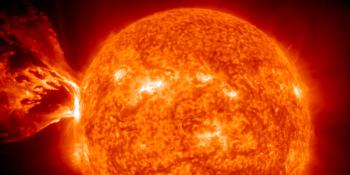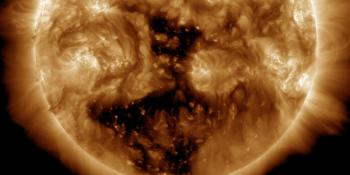Viewing archive of Sunday, 26 October 2014
Select the desired archive item
Evolution of sunspot region 2192
Solar activity is at high levels. We already saw an X2 solar flare today from sunspot region 2192 but this sunspot region continues to be active and is now firing M-class solar flares on a regular basis. The X2 solar flare from today unfortunately did not release a coronal mass ejection. In this article we take a look how sunspot region 2192 is developing. Our header image was taken by Sajad Sayadi on October 23, 2014 at Fasa/Fars/Iran. He captured this picture of our nearest star at sunset with a great view of sunspot region 2192. He captured this shot from the Observatory & Scietific Center of Fasa (OSCF) in south Iran with a 14 inch telescope. Stunning work!
X2.0 solar flare from sunspot region 2192
...and that is number five! Sunspot region 2192 again produced a major solar flare: X2.01 (R3-strong radio blackout) at 10:56 UTC. This was already it's fifth X-class solar flare and the 13th strongest solar flare of this solar cycle... however... just like all the other X-class solar flares that we have previously seen from this sunspot region... it again looks like it did not launch a coronal mass ejection.
Latest news
Latest forum messages
Support SpaceWeatherLive.com!
A lot of people come to SpaceWeatherLive to follow the Sun's activity or if there is aurora to be seen, but with more traffic comes higher server costs. Consider a donation if you enjoy SpaceWeatherLive so we can keep the website online!

Space weather facts
| Last X-flare | 2025/03/28 | X1.1 |
| Last M-flare | 2025/04/15 | M1.2 |
| Last geomagnetic storm | 2025/04/16 | Kp8- (G4) |
| Spotless days | |
|---|---|
| Last spotless day | 2022/06/08 |
| Monthly mean Sunspot Number | |
|---|---|
| March 2025 | 134.2 -20.4 |
| April 2025 | 120.5 -13.7 |
| Last 30 days | 116.6 -25.7 |


